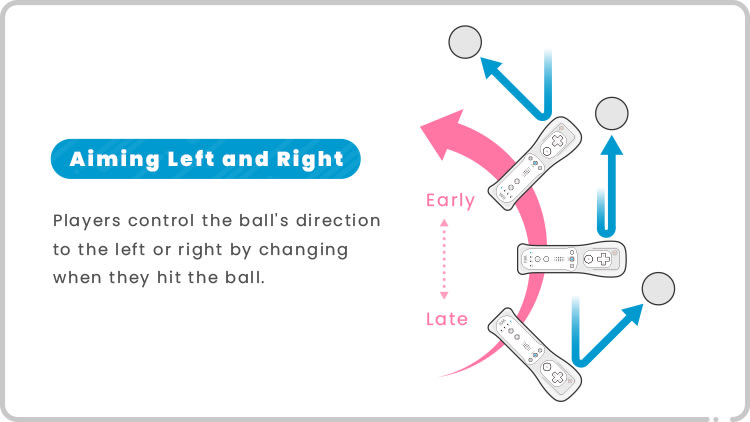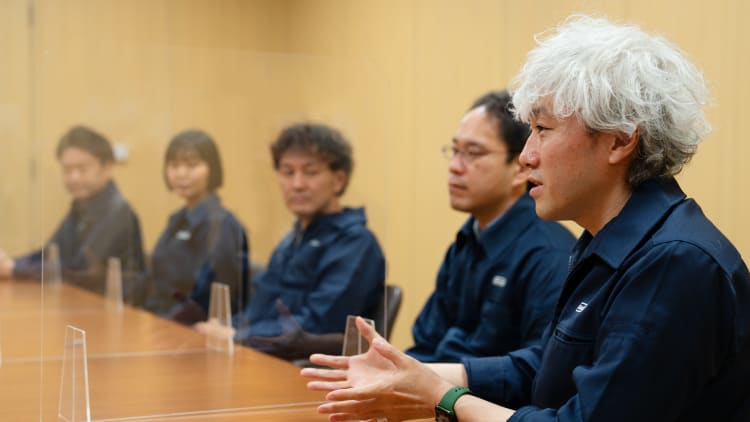-
Content pre-recorded in accordance with current COVID-19 health and safety guidelines.
-
This article is translated from the original Japanese content.
-
This interview was conducted before the game was released.
1:Aiming for the world’s easiest to invite, motion-based games
2: Over 90% detection
4:Playing with others is inherently fun
Part 2: Over 90% detection
You mentioned earlier that what was achieved on the Wii system was not easy to implement on the Nintendo Switch system. So I would like to ask the programmer Okane-san, what exactly are the differences between the Wii system and the Nintendo Switch system?
Okane: Primarily, Wii Sports used Wii Remote ™ (4) as a controller, and we incorporated it into the game while thinking about what gameplay could be performed with the Wii Remote. But with the Nintendo Switch system, it was the opposite. Initially, the idea of playing sports by swinging was already decided, and we had to figure out how to implement this idea with the Joy-Con controller. As a programmer, this required a lot of trial and error.
(4) The primary controller designed for the Wii system’s home game console, released in 2006. This controller has a vertical shape that resembles a remote control for a TV, and it is designed to enable intuitive and easy-to-understand operation at a time when Nintendo intended to expand the game population.
To the untrained eye, one would think that since one swings both the Wii remote and the Joy-Con controllers, and they should include a sensor for that purpose, it could be easily achieved ….
Okane: If you hold a Wii Remote, it has a certain weight and size. When players play tennis or bowling with this weight, it enables them to control the Wii remote naturally with just the right amount of turns for the game. Therefore, it was easy to guess how the players would hold and swing it, and as a programmer, it was relatively easy to also discover how it was swung. But the Joy-Con controller for the Nintendo Switch is much smaller than the Wii remote. So it varies a lot from person to person in the way they hold and move it.
Certainly, when the controllers are smaller, it is easier to swing the arms freely, and I understand that they can swing in many different directions. But how does this actually affect the game development process?
Okane: It’s hard to put the motion detection into practice: “if you swing like that, it has to react like that,” in a way that satisfies the players.
In a way that satisfies the players? Does that mean making sure that things like, “I thought I swung it, but it was not recognized,” will not happen?
Okane: Yes. Also things like, “I thought I swerved left, but it went right.” As we progressed, we were able to implement the detection so that about 80 to 90% of the time responded as expected at an early stage. However, it is very difficult to apply the final polish on motion controls so that they feel natural and completely satisfying when you use them. Both Shimamura-san and Yamashita-san mentioned earlier “which aims at the world’s most motion-based games that are easiest to invite.” To achieve this, it is crucial to work on detection beyond 90%.
What were your thoughts on this, Yamashita-san? Did you feel you could achieve the adjustments “beyond 90%”?
Yamashita: Well, it was harder than I thought. This is because when we actually made the game and played it with a group of people who had played the previous series, they were able to play it without much trouble. But when we invited someone who had never played this game before to try it, the ball did not fly at all in the direction they had expected. I can understand “the grip is different”, or “the swing is different”, but there were times when people said things like, “this is not how you move in the actual sport!” …
Not how you move in the actual sport? What does it mean?
Yamashita: Take volleyball, for example. In real volleyball, you do not move your arms and wrists when you bump. Once the player is in the striking position, he holds his hands in a fixed position and returns the ball using his knees to push through. This is the official way to encounter volleyball.

Yamashita: But if you’ve never played volleyball before, you would think they sent the ball into the air by swinging their hands and arms up, right? However, the programmer responsible for the development of volleyball was an experienced volleyball player. So the programmer also had the “official bump” feature required in the game. When we tried the prototype with everyone, as expected, everyone swung their hands up and held Joy-Con to hit the ball. Oddly enough, even those with volleyball experience did the same move. But the program was designed on the premise of “keeping your hands still” so that the ball would fly in the wrong direction. In other words, the programmer, who was an experienced volleyball player, created a game mechanic where the player had to keep his hands still, set the angle and strike …
It sounds like it’s hard to control unless you know the gameplay.
Yamashita: It is true. It’s fun when you know how to play with that gameplay. “Oh, so authentic! It’s like volleyball!” But when we tried it together without any explanation, almost all the arms snapped up. We all thought, “What are we going to do with this !?” So we get to a point where we think this is going to have to be a game mechanic where the player has to swing up. But then the responsible programmer, who has real volleyball experience, will be worried that the volleyball ability may be lost.
But even when people with actual volleyball experience played, they still swung their hands up, weren’t they?
Yamashita: Yes, they were. Given that, the only way to make a game that people who do not know anything about it can play naturally with a quick glance, by turning it into a gameplay where players, after all, swing their hands to encounter. … And then, after some discussion, all methods of identifying the movement were reworked.
Whether it’s the actual move or not, it’s actually easier to understand if the ball is flying in the direction you expect.
Okane: If the game is to be played for a long time and thoroughly, it can be an option to do so with authentic and correct volleyball form. However, I felt that it would be difficult to convey the fun of the game in a short amount of time, while the player read the operating instructions carefully when playing.
Are such adjustments only in volleyball? Have there been any adjustments in other sports as well?
Yamashita: There were fewer sports that actually went smoothly. (Laughs) In the planning phase, there were already some kind of adjustments needed for all sports. For example, badminton. The look is similar to Tennis from the previous games in the series. At that time, in Tennis, the direction you hit the ball back was determined by the time of the swing. If you swung at an earlier time, the ball would fly to the left, and if you swung at a later time, you could hit the ball to the right.

If you try to put the same concept into badminton and ask someone who does not know the premise of playing, they may say, “I do not know why the timing of the turn changes the direction in which the shuttlecock is flying!” Shimamura-san and I know that it is not the direction of the turn, but the time of the turn that determines in which direction the shuttlecock (the feather) flies, as we know the method of the previous titles. But those who played without knowing this premise will say that it just does not feel right.

Was it not possible to actually recognize the direction in which the Joy-Con controller is swung in Tennis and determine the direction in which the ball will be hit according to this recognition?
Yamashita: When you actually play it, that method is very difficult. When we try to find out the direction of the turn and use it to determine the direction in which the ball is flying, it makes the controls unstable and the ball does not fly in the direction you expect it to. Even when Wii Sports and Wii Sports Resort was developed, I was told by the programmers, “Please do not do it like that.” However, there were suggestions from employees who were not familiar with the trial-and-error process at the time, who said, “We would like to recognize the direction in which the shuttlecock is flying in the direction of the swing.”
Okane: I understand well that badminton is a sport where shuttlecock will fly in the direction you swing. I knew it was going to be difficult as it had already been experimented with again and again earlier in the series.
Yamashita: As an instructor who has experience working on previous titles, asking them to achieve it when you know it is technically difficult was tantamount to “losing”. So the instructor has to solve the problem with ideas on how to make the motion controls feel natural and not through technology. I said, “That’s what instructors do!” But eventually I got them to solve it with technology. But there was no way it would have been that easy.
How did you overcome in this title what seemed technically impossible at the time?
Okane: We just tried and failed a lot. In terms of new technology, we tried deep learning (5), which was not available at the time Wii Sports was developed.
Okane: For example, we asked different people to “swing as if you hit left” and “now swing as if you hit right”, and repeated the process over and over again to get a large amount of data. It is a technology that detects whether the player is trying to hit the ball to the right (or left) by statistically analyzing the data collected. So by incorporating such technology and experimenting with this and that, we tried to bring it up to a level that everyone could agree on.
(5) Machine learning technology captures large amounts of data, such as images and video, into computers and analyzes the characteristics of the data.
Yamashita-san mentioned earlier that it is very difficult, but Okane-san, how did you feel about the direction of the turn that determines the direction of the ball?
Okane: I thought it would be hard. Deep learning is an excellent technology, but it is not magic. If we can get enough data “from the beginning of the turn to the end of the turn,” we can possibly estimate the correct direction. However, if the ball reacts and flies out after the player has finished swinging, players will feel that it is not responding and it is one step behind. So if we try to use data just before the end of the turn, the correct motion cannot be estimated because there will not be enough data this time. In other words, there is a trade-off between aiming for “accurate detection” and “satisfactory response as motion control.” So we made adjustments over and over again and said things like, “I think it’s somewhere around here! … No, maybe it’s somewhere around here!”

But with the accumulation of these constant efforts, the 80-90% you mentioned earlier came closer to 100%, right?
Okane: Yes, so I would say we could achieve about 90 to 95% detection quite smoothly. But the last few percent were really tough … For example, when a player serves in Badminton, and even though the shuttlecock flies as expected nine out of 10 times, if the player misses once, they will think, “Hmm, it’s hard to control … “So even though it is impossible to reach 100%, it is very important to work on this last small percentage, even if it is only a little. It is no longer something that can be solved with the latest technology, so we have all worked hard to get as many as possible involved and make detailed adjustments.
Shimamura: Every day, we hit 200 times each to the right, left, and center to see how the latest adjustments worked. My right arm was so pumped and crab-like. (laughs)
I guess it’s also hard to develop a motion-based game when it comes to testing …
Yamashita: It’s a sequel to the previous games in the series and also a motion based game, but as explained it could not just be a simple gate. I think all sports were close to being rebuilt from scratch in a way that was adapted to the Nintendo Switch system.
Read more – Part 3: A sense of continuity
Mild violence
In-game purchases, users interact
